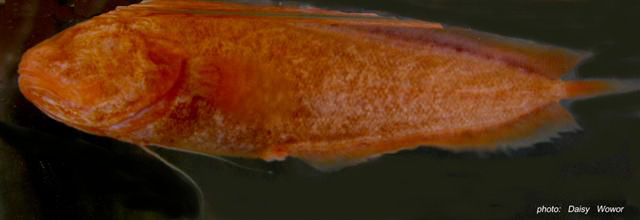| Dinematichthyidae (Viviparous brotula) |
| 8 cm SL (male/unsexed) |
|
demersal; freshwater |
| Asia: Indonesia. Muna Island, southeast of Sulawesi (Ref. 83398). |
|
This species is distinct within the genus by being eyeless, with dorsal fin rays (78-81) and head length (30.5-32.5%). Further distinguished by the following, vertebrae 11-12 + 29-30; anal fin rays 63-65; long gill rakers 3-4; pseudobranchial filaments absent; scales on cheek in a narrow patch, none on the opercle; pointed outer pseudoclasper only slightly longer than inner pseudoclasper, the pseudoclaspers are connected anteriorly; color in life red (Ref. 83398). |
| This species is easily caught y hand nets for these kept close to the rocks often upside down. An interesting nocturnal migration was observed in Moko Morete as dozens of fish from the lightless parts of the cave appeared in the blue hole after dark. There was much more food available in the blue hole than in the oligotrophic cave habitat as the blue hole was exposed to daylight all day long. It was also risky to stay in the blue hole as many specimens were eaten by snakes. The salinity in the caves vary, 5-10 ppm in the surface layers and about 30 ppm in the bottom layers with a sharp halocline at 15-20 m depth. The absence of eyes indicates that the species has evolved under dark cave conditions. The presence of long, retrorse fangs also indicate that they can take relatively large prey. The only identifiable stomach content, judged from radiographs, is two 2 mm long gastropods. Two females have eggs up to 0.8 mm in diameter, but no embryos were found. The 6.2 cm SL female had about 250 eggs 0.6-0.8 mm in diameter. Four males have a well-developed intromittent organ and histological sections of the testes of one of these (MNHN 2009-0154) show numerous spermatophores in the testicular duct (Ref. 83398). |
|
Data deficient (DD); Date assessed: 15 August 2019 Ref. (130435)
|
| harmless |
Source and more info: www.fishbase.org. For personal, classroom, and other internal use only. Not for publication.

